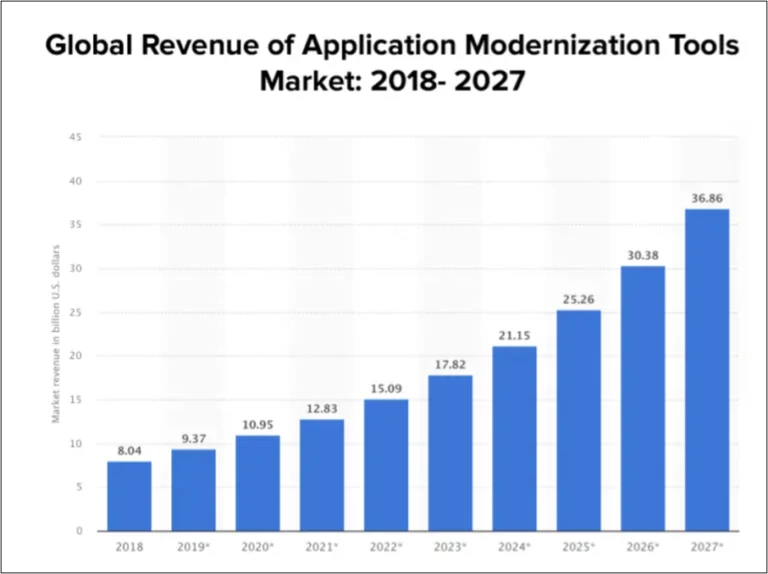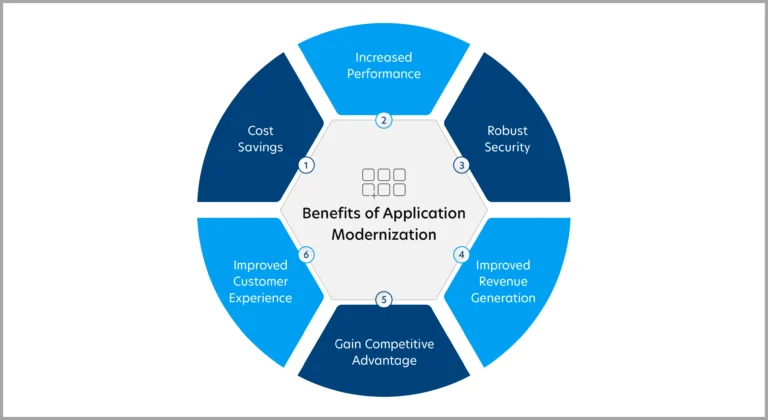Key Challenges to Application Modernization
When we think of application modernization, we tend to think “legacy” modernization.
Read moreIn recent years, with the advent of emerging technologies such as cloud, AI/ML, IoT, data analytics, etc., the IT landscape has undergone a drastic transformation. However, 90% of businesses are struggling to harness the complete potential of digital technologies due to their reliance on outdated monolithic applications. That’s not all; IT companies that depend on outdated applications often encounter hurdles like incompatibility, undesired maintenance costs, and, most importantly, the inability to innovate to meet emerging digital business demands.

As a solution, business leaders of forward-thinking companies across different industries are focusing on modernizing their legacy systems using new technology platforms and tools. In fact, reports state that the global application modernization tools market is expected to become worth $36.86 billion by 2027, considering the increasing demand for application modernization tools to support enterprise digital transformation journeys.
Let’s now move on to the seven approaches businesses can adopt to modernize their traditional applications to stay ahead of the competitive curve:
Leveraging the encapsulation approach in modern business applications can help to enhance security, portability, maintainability, and scalability, thereby enabling organizations to stay competitive in today’s fast-paced digital landscape.
Encapsulation can be leveraged to modernize business applications in various ways. Firstly, encapsulating legacy code within modern frameworks can help to isolate the code from the underlying infrastructure, making it more portable and easier to maintain. Secondly, encapsulating sensitive data within secure containers can help protect it from unauthorized access and cyber threats.
A modernization approach that involves moving an existing application to a new environment without making any significant changes to the application’s architecture or functionality. Rehosting can simplify application management by reducing the complexity of on-premise infrastructure, enabling organizations to focus on core business activities.
The overall functionalities and user experience are optimized and tailored in accordance with the overall business objectives, but the core application is not reconstructed.
The expanding digital era demands businesses be cloud-friendly. Refactoring involves changing the program and some code to benefit from a public cloud. It also enables you to create stand-alone services to facilitate the usability of app functionality.
Monolithic apps are fragmented into a cluster of services and placed within their containers after re-architecting. As a result, organizations gain various advantages, including shorter time to market, lower costs, increased business agility, and improved customer experience.
Rebuild resembles the rearchitect method, but it starts from scratch rather than remodelling here. This strategy enables the development of a cloud-based application that ultimately helps businesses increase innovation, minimize overall development costs, and stay ahead of technical improvements.
Legacy apps can be replaced with more elegant cloud-based solutions if they still offer some useful functionality to a business. The objective is to redesign the outdated monolithic program to adhere to a modern microservices architecture. This can involve replacing proprietary plugins, obsolete tools, or technologies with open-source solutions.
Maintaining legacy applications without considering modernization is a way to end up with high-risk, low-value apps that negatively impact your business. Modernization has hidden advantages in some areas, including increased team expertise, enhanced operations and development procedures, faster application value delivery to clients, and reduced failure risk.
Technology and your business model, strategies, and customer expectations become obsolete with time. Moreover, legacy systems are common bottlenecks that limit business growth and expansion in today’s digital age. Modernizing outdated and inefficient IT systems and applications can help businesses in multiple ways:

Maintaining outdated applications can be expensive for organizations, primarily when hosted in costly on-premises data centers. Moreover, engaging professionals to maintain legacy systems can also be costly, considering the increasing shortage of skilled experts who can handle old tools and outdated technology. Updating legacy systems can help businesses obtain 30-50% lower application maintenance and operating expenses, enabling them to stay ahead of what the public cloud offers.
Legacy applications’ incompatibility with modern hardware and systems frequently affects productivity, leading to lags, glitches, and other issues. Modernizing systems can help improve team collaboration, increase productivity, and boost performance.
Older applications expose organizations to higher security risks as outdated programs cannot be used with current security authentication procedures. Modernizing applications can eliminate any security risks that older systems may have.
Legacy systems are incompetent to meet the changing expectations of the digital markets, making it difficult for businesses to introduce new features, services, and functions that enhance the customer experience and increase revenue. Modern applications enable companies to introduce new procedures or services to enhance the client experience, leading to increased sales.
Embracing application modernization can help companies achieve greater heights by incorporating cutting-edge platforms and technologies, outpacing laggards, and fulfilling their business needs.
A company’s success is based on how well it provides customer service. Using older versions of applications can make it difficult for businesses to improve the customer experience. Modernizing current applications can enable businesses to benefit from the public cloud environment, offering first-rate client assistance.
For instance, Goldman Sachs, one of the world’s largest financial services firms, struggled to drive technological innovation. Legacy application modernization helped streamline processes, boost developer productivity, and enhance customer satisfaction, enabling the banking behemoth to carry out critical business procedures with speed and efficiency successfully.
Modernizing applications is critical for businesses to stay relevant and competitive in today’s digital landscape. By adopting one or more of the modernization techniques we’ve discussed, companies can benefit from improved agility, scalability, security, and cost savings. However, modernizing applications can be a complex and challenging process. That’s where Quinnox comes in. Our experts can help businesses navigate the modern application development process and ensure a smooth transition to modernized applications that meet their unique needs. With our proven expertise and experience, businesses can deliver innovative solutions that drive business growth and success.
Connect with us and accelerate business agility by developing new digital models today!
When we think of application modernization, we tend to think “legacy” modernization.
Read moreIntegration has taken many different forms in the organization - from team collaboration to application data exchange.
Read moreAccording to AWS Report, 67% of businesses believe that to stay competitive, picking up modern applications is essential. That’s not all.
Read moreGet in touch with Quinnox Inc to understand how we can accelerate success for you.